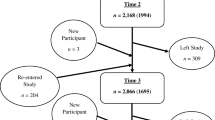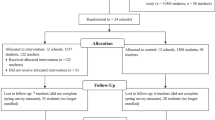Abstract
School-based youth violence prevention programs, particularly those focused on middle school students, have generally had limited effects that are often not sustained over time. Although many interventions focus on teaching social–cognitive skills, few studies have explored the extent to which students master these skills, actually use them, and find them effective in dealing with problem situations. This study examined these issues based on interviews with 141 students attending one county and two urban middle schools in classrooms where the Second Step violence prevention program had been implemented. We coded interviews to assess participants’ general reactions to the interventions, use of skills, and effectiveness of skills. We also asked participants to describe outcomes they experienced when they used specific skills taught in the intervention in response to problem situations. Participants had generally positive reactions to the intervention. Their suggestions for improving the intervention primarily concerned improving its relevance. Participants described changes they had made based on the intervention, particularly controlling anger and improving relations with others. Their responses indicated that they sometimes misunderstood or misused specific intervention skills, especially problem solving and empathy. Students’ descriptions of the outcomes they experienced when using intervention skills were not uniformly positive. This was especially true for situations involving peers such as peer pressure and bullying. These results underscore the need for more intensive efforts to ensure that students master intervention skills and are able to use them correctly. In addition, interventions should address the broader social context (e.g., peers, school) to maximize the effectiveness of skills.


Similar content being viewed by others
References
Aber, J. L., Jones, S. M., Brown, J. L., Chaudry, N., & Samples, F. (1998). Resolving conflict creatively: Evaluating the developmental effects of a school-based violence prevention program in neighborhood and classroom context. Development and Psychopathology, 10, 187–213. doi:10.1017/S0954579498001576.
Berkel, C., Mauricio, A., Schoenfelder, E., & Sandler, I. (2011). Putting the pieces together: An integrated model of program implementation. Prevention Science, 12, 23–33. doi:10.1007/s11121-010-0186-1.
Bosworth, K., Espelage, D., DuBay, T., Daytner, G., & Karageorge, K. (2000). Preliminary evaluation of a multimedia prevention program for adolescents. American Journal of Health Behavior, 24, 268–280.
Boxer, P., & Dubow, E. F. (2002). A social–cognitive information-processing model for school-based aggression reduction and prevention programs: Issues for research and practice. Applied and Preventive Psychology, 10, 177–192. doi:10.5993/AJHB.24.4.3.
Brown, J. A., Jimerson, S. R., Dowdy, E., Gonzalez, V., & Stewart, K. (2012). Assessing the effects of school-wide Second Step implementation in a predominantly English language learner, low SES, Latino sample. Psychology in the Schools, 49(9), 864–875. doi:10.1002/pits.21639.
Centers for Disease Control and Prevention. (2007). The effectiveness of universal school-based programs for the prevention of violent and aggressive behavior: A report on recommendations of the Task Force on Community Preventive Services. Morbidity and Mortality Weekly Report, 56(RR-7), 1–11.
Committee for Children. (1997a). Second Step: A violence prevention curriculum; elementary school. Seattle, WA: Committee for Children.
Committee for Children. (1997b). Second Step: A violence prevention curriculum; middle school/junior high. Level 1 Foundation Lessons. Seattle, WA: Committee for Children.
Committee for Children. (2008). Second Step: Student success through prevention program. Seattle, WA: Committee for Children.
Cooke, M. B., Ford, J., Levine, J., Bourke, C., Newell, L., & Lapidus, G. (2007). The effects of city-wide implementation of “Second Step” on elementary school students’ prosocial and aggressive behaviors. The Journal of Primary Prevention, 28(2), 93–115. doi:10.1007/s10935-007-0080-1.
Durlak, J. A., Weissberg, R. P., Dymnicki, A. B., Taylor, R. D., & Schellinger, K. B. (2011). The impact of enhancing students’ social and emotional learning: A meta-analysis of school-based universal interventions. Child Development, 82, 405–432. doi:10.1111/j.1467-8624.2010.01564.x.
Edwards, D., Hunt, M. H., Meyers, J., Grogg, K. R., & Jarrett, O. (2005). Acceptability and student outcomes of a violence prevention curriculum. The Journal of Primary Prevention, 26, 401–418. doi:10.1007/s10935-005-0002-z.
Espelage, D. L., Low, S., Polanin, J. R., & Brown, E. C. (2013). The impact of a middle school program to reduce aggression, victimization, and sexual violence. Journal of Adolescent Health, 53, 180–186. doi:10.1016/j.jadohealth.2013.02.021.
Farrell, A. D., & Camou, S. (2006). School-based interventions for youth violence prevention. In J. R. Lutzker (Ed.), Preventing violence: Research and evidence-based intervention strategies (pp. 125–145). Washington, DC: American Psychological Association. doi:10.1037/11385-005.
Farrell, A. D., Erwin, E. H., Allison, K., Meyer, A. L., Sullivan, T. N., Camou, S., et al. (2007). Problematic situations in the lives of urban African American middle school students: A qualitative study. Journal of Research on Adolescence, 17, 413–454. doi:10.1111/j.1532-7795.2007.00528.x.
Farrell, A. D., & Flannery, D. J. (2006). Youth violence prevention: Are we there yet? Aggression and Violent Behavior, 11, 138–150. doi:10.1016/j.avb.2005.07.008.
Farrell, A. D., Henry, D. B., & Bettencourt, A. (2013). Methodological challenges examining subgroup differences: Examples from universal school-based youth violence prevention trials. Prevention Science, 14, 121–133. doi:10.1007/s11121-011-0200-2.
Farrell, A. D., Mays, S., Bettencourt, A., Erwin, E. H., Vulin-Reynolds, M., & Allison, K. W. (2010). Environmental influences on fighting versus nonviolent behavior in peer situations: A qualitative study with urban African American Adolescents. American Journal of Community Psychology, 46, 19–35. doi:10.1007/s10464-010-9331-z.
Farrell, A. D., Meyer, A. L., & White, K. S. (2001). Evaluation of responding in peaceful and positive ways (RIPP): A school-based prevention program for reducing violence among urban adolescents. Journal of Clinical Child Psychology, 30, 451–463. doi:10.1207/S15374424JCCP3004_02.
Farrell, A. D., Sullivan, T. N., Kliewer, W., Allison, K., Erwin, E. H., Meyer, A. L., et al. (2006). Peer and school problems in the lives of urban adolescents: frequency, difficulty, and relation to adjustment. Journal of School Psychology, 44, 169–190. doi:10.1016/j.jsp.2006.02.001.
Ferguson, C. J., San Miguel, C., Kilburn, J. C., & Sanchez, P. (2007). The effectiveness of school-based anti-bullying programs A meta-analytic review. Criminal Justice Review, 32, 401–414. doi:10.1177/0734016807311712.
Finkelhor, D., Turner, H., Ormrod, R., & Hamby, S. L. (2009). Violence, abuse, and crime exposure in a national sample of children and youth. Pediatrics, 124, 1411–1423. doi:10.1542/peds.2009-0467.
Frey, K. S., Hirschstein, M. K., & Guzzo, B. A. (2000). Second Step: Preventing aggression by promoting social competence. Journal of Emotional and Behavioral Disorders, 8(2), 103–112. doi:10.1177/106342660000800206.
Frey, K. S., Nolen, S. B., Van Schoiack Edstrom, L., & Hirschstein, M. K. (2005). Effects of a school-based social-emotional competence program: Linking children’s goals, attributions, and behavior. Applied Developmental Psychology, 26, 171–200. doi:10.1016/j.appdev.2004.12.002.
Grossman, D. C., Neckerman, H. J., Koepsell, T. D., Liu, P., Asher, K. N., Beland, K., et al. (1997). Effectiveness of a violence prevention curriculum among children in elementary school: A randomized controlled trial. Journal of the American Medical Association, 277(20), 1605–1611. doi:10.1001/jama.1997.03540440039030.
Grumm, M., Hein, S., & Fingerle, M. (2012). Children’s subjective perceptions of an aggression prevention program. International Journal of Developmental Science, 6, 97–106. doi:10.3233/DEV-2012-11071.
Henry, D. B., Dymnicki, A. B., Schoeny, M. E., Meyer, A. L., Martin, N. C., & MVPP. (2013). Middle school students overestimate normative support for aggression and underestimate normative support for nonviolent problem-solving strategies. Journal of Applied School Psychology, 43, 433–445.
Hervey, L., & Kornblum, R. (2006). An evaluation of Kornblum’s body-based violence prevention curriculum for children. The Arts in Psychotherapy, 33, 113–129. doi:10.1016/j.aip.2005.08.001.
Howard, K. A., Flora, J., & Griffin, M. (1999). Violence-prevention programs in schools: State of the science and implications for future research. Applied and Preventive Psychology, 8, 197–215. doi:10.1016/S0962-1849(05)80077-0.
MacKinnon, D. P., Taborga, M.P., & Morgan-Lopez, A. A. (2002). Mediation designs for tobacco prevention research. Drug and Alcohol Dependence, 68(Suppl 1), S69–S83. doi:10.1016/S0376-8716(02)00216-8
Matjasko, J. L., Vivolo-Kantor, A. M., Massetti, G. M., Holland, K. M., Holt, M. K., & Dela Cruz, J. (2012). A systematic meta-review of evaluations of youth violence prevention programs: Common and divergent findings from 25 years of meta-analyses and systematic reviews. Aggression and Violent Behavior, 17, 540–552. doi:10.1016/j.avb.2012.06.006.
McMahon, S. D., & Washburn, J. J. (2003). Violence prevention: An evaluation of program effects with urban African American students. The Journal of Primary Prevention, 24, 43–62. doi:10.1023/A:1025075617356.
Meyer, A. L., & Farrell, A. D. (1998). Social skills training to promote resilience and reduce violence in African American middle school students. Education and Treatment of Children, 21, 461–488.
Moffitt, T. E. (1993). Adolescent-limited and life-course persistent antisocial behavior: A developmental taxonomy. Psychological Review, 100(4), 674–701. doi:10.1037/0033-295X.100.4.674.
Mytton, J. A., DiGuiseppi, C., Gough, D. A., Taylor, R. S., & Logan, S. (2002). School-based violence prevention programs: Systematic review of secondary prevention trials. Archives of Pediatric and Adolescent Medicine, 156, 752–762. doi:10.1001/archpedi.156.8.752.
Orpinas, P., Kelder, S., Frankowski, R., Murray, N., Zhang, Q., & McAlister, A. (2000). Outcome evaluation of a multi-component violence-prevention program for middle schools: The Students for Peace project. Health Education Research, 15, 45–58. doi:10.1093/her/15.1.45.
Orpinas, P., Parcel, G. S., McAlister, A., & Frankowski, R. (1995). Violence prevention in middle schools: A pilot evaluation. Journal of Adolescent Health, 17, 360–371. doi:10.1016/1054-139X(95)00194-W.
Shapiro, J. P., Burgoon, J. D., Welker, C. J., & Clough, J. B. (2002). Evaluation of The Peacemakers Program: School-based violence prevention for students in grades four through eight. Psychology in the Schools, 39, 87–100. doi:10.1002/pits.10040.
Smith, B. H., & Low, S. (2013). The role of social-emotional learning in bullying prevention efforts. Theory Into Practice, 52, 280–287. doi:10.1080/00405841.2013.829731.
Smith, J. D., Schneider, B. H., Smith, P. K., & Ananiadou, K. (2004). The effectiveness of whole-school antibullying programs: A synthesis of evaluation research. School Psychology Review, 33, 547–560.
Sullivan, T. N., Sutherland, K. S., Farrell, A. D., & Taylor, K. A. (in press). An evaluation of Second Step: What are the benefits for youth with and without disabilities? Remedial and Special Education.
Sutherland, K. S., Wright, S., & Sullivan. T. N. (2008, November). Measuring social competence skill acquisition using curriculum-based measures: Development of measures and initial findings. Paper presented at the 32nd annual severe behavior disorders of children and youth conference, Tempe, AZ.
Ttofi, M. M., & Farrington, D. P. (2011). Effectiveness of school-based programs to reduce bullying: A systematic and meta-analytic review. Journal of Experimental Criminology, 7, 27–56. doi:10.1007/s11292-010-9109-1.
U.S. Department of Health and Human Services. (2001). Youth violence: A report of the Surgeon General. Washington, DC: United States Department of Justice.
Van Schoiack Edstrom, L., Frey, K. S., & Beland, K. (2002). Changing adolescents’ attitudes about relational and physical aggression: An early evaluation of a school-based intervention. School Psychology Review, 31(2), 201–216.
Wilson, S. J., Lipsey, M. W., & Derzon, J. H. (2003). The effects of school-based intervention programs on aggressive behavior: A meta-analysis. Journal of Consulting and Clinical Psychology, 71(1), 136–149. doi:10.1037/0022-006X.71.1.136.
Acknowledgments
This study was funded by the National Center for Injury Prevention and Control, Centers for Disease Control and Prevention, CDC Cooperative Agreements 5U49CE000730 and 5U01CE001956. The findings and conclusions in this report are those of the authors and do not necessarily represent the official position of the Centers for Disease Control and Prevention. The authors express their appreciation to the following individuals who participated in the coding of transcripts: Allie Baylor, Amie Bettencourt, Emily Butt, Jessica Garcia, Alison Kramer-Kuhn, Shanaye La Beaud, Kalyn Salinsky, Denicia Titchner, and Kelly Zbojovksy.
Conflict of interest
The authors declare that they have no conflict of interest.
Author information
Authors and Affiliations
Corresponding author
Rights and permissions
About this article
Cite this article
Farrell, A.D., Mehari, K., Mays, S. et al. Participants’ Perceptions of a Violence Prevention Curriculum for Middle School Students: Was It Relevant and Useful?. J Primary Prevent 36, 227–246 (2015). https://doi.org/10.1007/s10935-015-0391-6
Published:
Issue Date:
DOI: https://doi.org/10.1007/s10935-015-0391-6




